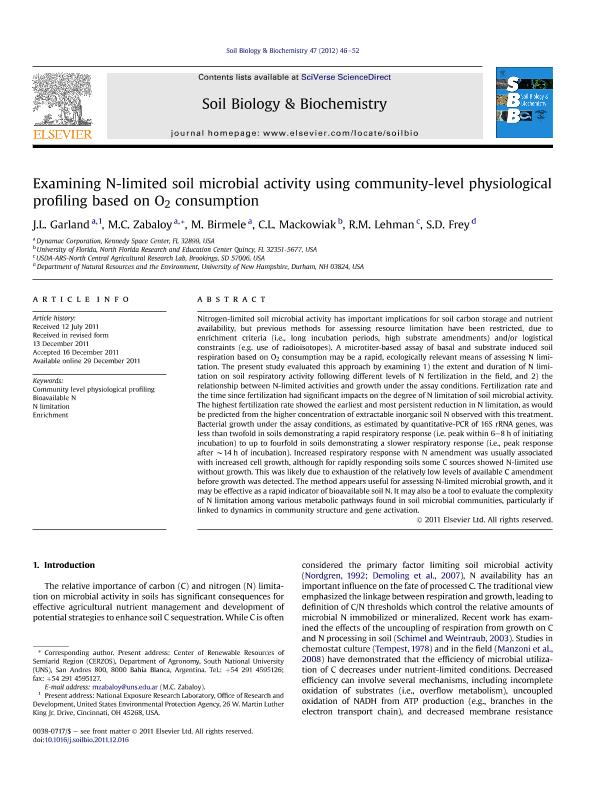Mostrar el registro sencillo del ítem
dc.contributor.author
Garland, J. L.
dc.contributor.author
Zabaloy, Maria Celina

dc.contributor.author
Birmele, M.
dc.contributor.author
Mackowiak, C. L.
dc.contributor.author
Lehman, R. M.
dc.contributor.author
Frey, S. D.
dc.date.available
2017-07-07T19:18:42Z
dc.date.issued
2012-04
dc.identifier.citation
Garland, J. L.; Zabaloy, Maria Celina; Birmele, M.; Mackowiak, C. L.; Lehman, R. M.; et al.; Examining N-limited soil microbial activity using community-level physiological profiling based on O2 consumption; Elsevier; Soil Biology And Biochemistry; 47; 4-2012; 46-52
dc.identifier.issn
0038-0717
dc.identifier.uri
http://hdl.handle.net/11336/19868
dc.description.abstract
Nitrogen-limited soil microbial activity has important implications for soil carbon storage and nutrient availability, but previous methods for assessing resource limitation have been restricted, due to enrichment criteria (i.e., long incubation periods, high substrate amendments) and/or logistical constraints (e.g. use of radioisotopes). A microtiter-based assay of basal and substrate induced soil respiration based on O2 consumption may be a rapid, ecologically relevant means of assessing N limitation. The present study evaluated this approach by examining 1) the extent and duration of N limitation on soil respiratory activity following different levels of N fertilization in the field, and 2) the relationship between N-limited activities and growth under the assay conditions. Fertilization rate and the time since fertilization had significant impacts on the degree of N limitation of soil microbial activity. The highest fertilization rate showed the earliest and most persistent reduction in N limitation, as would be predicted from the higher concentration of extractable inorganic soil N observed with this treatment. Bacterial growth under the assay conditions, as estimated by quantitative-PCR of 16S rRNA genes, was less than twofold in soils demonstrating a rapid respiratory response (i.e. peak within 6-8 h of initiating incubation) to up to fourfold in soils demonstrating a slower respiratory response (i.e., peak response after 14 h of incubation). Increased respiratory response with N amendment was usually associated with increased cell growth, although for rapidly responding soils some C sources showed N-limited use without growth. This was likely due to exhaustion of the relatively low levels of available C amendment before growth was detected. The method appears useful for assessing N-limited microbial growth, and it may be effective as a rapid indicator of bioavailable soil N. It may also be a tool to evaluate the complexity of N limitation among various metabolic pathways found in soil microbial communities, particularly if linked to dynamics in community structure and gene activation.
dc.format
application/pdf
dc.language.iso
eng
dc.publisher
Elsevier

dc.rights
info:eu-repo/semantics/openAccess
dc.rights.uri
https://creativecommons.org/licenses/by-nc-sa/2.5/ar/
dc.subject
Community Level Physiological Profiling
dc.subject
Bioavailable N
dc.subject
N Limitation
dc.subject
Enrichment
dc.subject.classification
Biología Celular, Microbiología

dc.subject.classification
Ciencias Biológicas

dc.subject.classification
CIENCIAS NATURALES Y EXACTAS

dc.subject.classification
Ciencias del Suelo

dc.subject.classification
Agricultura, Silvicultura y Pesca

dc.subject.classification
CIENCIAS AGRÍCOLAS

dc.title
Examining N-limited soil microbial activity using community-level physiological profiling based on O2 consumption
dc.type
info:eu-repo/semantics/article
dc.type
info:ar-repo/semantics/artículo
dc.type
info:eu-repo/semantics/publishedVersion
dc.date.updated
2017-07-03T14:51:26Z
dc.journal.volume
47
dc.journal.pagination
46-52
dc.journal.pais
Países Bajos

dc.journal.ciudad
Amsterdam
dc.description.fil
Fil: Garland, J. L.. Dynamac Corporation; Estados Unidos
dc.description.fil
Fil: Zabaloy, Maria Celina. Consejo Nacional de Investigaciones Científicas y Técnicas. Centro Científico Tecnológico Conicet - Bahía Blanca. Centro de Recursos Naturales Renovables de la Zona Semiarida. Universidad Nacional del Sur. Centro de Recursos Naturales Renovables de la Zona Semiarida; Argentina
dc.description.fil
Fil: Birmele, M.. Dynamac Corporation; Estados Unidos
dc.description.fil
Fil: Mackowiak, C. L.. University of Florida; Estados Unidos
dc.description.fil
Fil: Lehman, R. M.. North Central Agricultural Research Lab; Estados Unidos
dc.description.fil
Fil: Frey, S. D.. University Of New Hampshire; Estados Unidos
dc.journal.title
Soil Biology And Biochemistry

dc.relation.alternativeid
info:eu-repo/semantics/altIdentifier/url/http://www.sciencedirect.com/science/article/pii/S0038071711004408
dc.relation.alternativeid
info:eu-repo/semantics/altIdentifier/doi/http://dx.doi.org/10.1016/j.soilbio.2011.12.016
Archivos asociados
